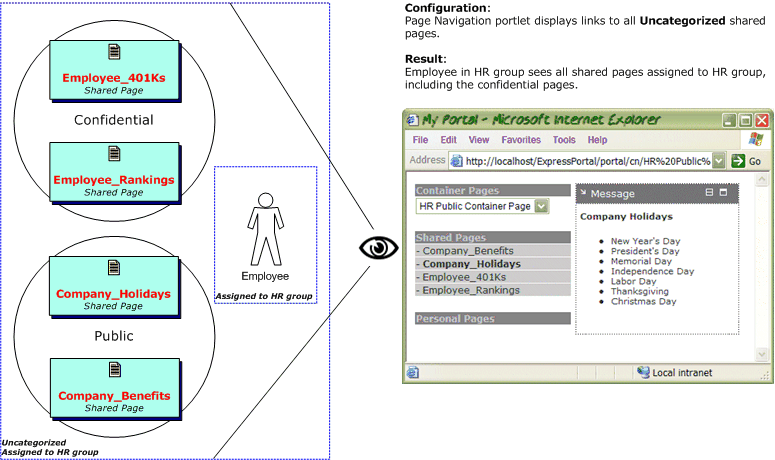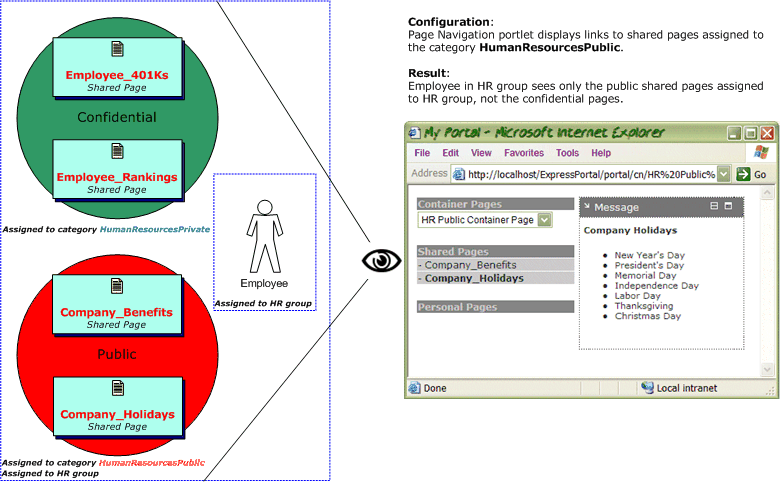
Portal Guide
CHAPTER 8
This chapter explains how portal administrators can use page categories to filter access to portal pages. It covers the following topics:
Portal administrators can use page categories in conjunction with the Page Navigation and Page Header portlets to filter access to individual container pages and shared pages within ACL groups. This level of control is useful when you need to override access permissions assigned to users or groups—for example, if a user is a member of two groups, but should not be allowed to view specific shared pages assigned to one of the groups.
The Page Navigation and Page Header portlets can facilitate navigation of a portal application from a single container page. When placed on a container page, these portlets can be configured to display navigation links to pages available to the current user based on categories.
Consider this scenario: The Human Resources department in a corporation has an ACL group called HR and a portal that contains a mix of confidential and public pages. All employees in a corporation are assigned to the HR ACL group, but only a small subset of employees—authorized staff in the Human Resources department—can view the confidential pages.
When all Human Resources portal pages are uncategorized, they can be viewed by every employee, as shown:

To restrict access to the confidential portal pages, the portal administrator creates two page categories: HumanResourcesPublic for the public HR pages and HumanResourcesPrivate for the private HR pages.
The administrator then configures the Page Navigation portlet on a container page to display links only to pages assigned to the category HumanResourcesPublic. By assigning this container page to the unauthorized employees in the HR group, the administrator allows them to view public HR pages, but restricts their access to the private ones, as shown:

Here are the steps a portal administrator must follow to filter page navigation by category:
Create one or more page categories, as described in Creating page categories.
Assign categories to container pages and shared pages, as described in Assigning categories to pages.
Configure the Page Navigation or Page Header portlet on a container page to restrict access to pages by category, as described in Filtering navigation links by category.
Assign the container page or shared page to the appropriate users or groups.
This procedure describes how to create page categories in exteNd Director.
With your project open in the exteNd Director development environment, select File>New>File.
An untitled portal category descriptor opens in graphical view in exteNd Director.
Enter the following information in the portal category descriptor fields:
For example, here are the values entered for a category that will be used to restrict access to shared pages designed only for Human Resources staff:
Select File>Save to save the category descriptor.
The Save As dialog opens. By default, the category will be saved as an XML descriptor file in the portal-category folder of the resource set. The file name will be the same as the category name.
Keep the defaults and click Save in the Save As dialog.
In the example above, the category descriptor is saved in a file called HumanResourcesPrivate.xml. Here is what the descriptor looks like:
<?xml version="1.0" encoding="UTF-8"?>
<!DOCTYPE portal-category PUBLIC "-//SilverStream Software, LLC//DTD Portal Category 5.0//EN" "portal-category_5_0.dtd">
<portal-category>
<display-name>HumanResourcesPrivate</display-name>
<description>Shared pages for HR staff</description>
<category-type>sharedpage</category-type>
</portal-category>
Now you are ready to assign the category to one or more pages, as described in Assigning categories to pages.
The following procedure describes how to assign categories to pages. You must assign the category to pages of the same type as the category. For example, if you created a category for shared pages, you can assign that category only to shared pages—and not to container pages.
Only portal administrators can assign pages to categories.
 To assign categories to pages:
To assign categories to pages:
Start the Portal Administrator tool.
For instructions, see the section on starting the Portal Administration tool.
The Shared and Container Page Administration page opens in your browser:
Click Maintain Shared Pages or Maintain Container Pages, depending on the type of page you want to categorize.
The appropriate section of the Portal Administration tool opens in your browser. Here is an example of a shared page administration page:
If you need to search for the page of interest, enter search criteria and click Show Pages.
TIP: You can streamline your search by selecting a category of pages or by entering the initial letters of the page name in the Starts with field.
Select the page of interest from the list of pages returned, then check the categories you want to assign to the page, as in this example:
The page appears under its new category (or categories) in the list of pages.
Select Administration Home and leave the Portal Administration tool running for the next procedure, Filtering navigation links by category.
This procedure shows you how to configure a Page Navigation portlet or Page Header portlet to filter navigation links by categories on a container page.
Your Portal Administration tool should be running in your browser, displaying its home page.
 To display navigation links by category:
To display navigation links by category:
In the Portal Administration home page select Maintain Container Pages.
The container page administration page opens in your browser, as in this example:
If you need to search for the page of interest, enter search criteria and click Show Pages.
TIP: You can streamline your search by selecting a category of pages or by entering the initial letters of the page name in the Starts with field.
Select the desired container page from the list of pages returned and click Choose Content in the Page Tasks list:
If the container page does not contain a Page Navigation or Page Header portlet, add one of these portlets by selecting it from the Available Portlets list and clicking Add.
Select the Page Navigation or Page Header portlet you just added in the Selected Portlets list, then click Portlet Preferences.
The Portlet Preferences portlet opens in a new browser window.
Scroll to the appropriate category filter preferences:
|
If you want to filter: |
Scroll to: |
|---|---|
|
Container pages |
Container pages category filter |
|
Shared pages |
Shared pages category filter |
For example, here is the Shared pages category filter preference:
Enter the names of the categories to use for filtering, one per text field.
The categories you enter determine which pages can be accessed from the navigation links of the Page Navigation or Page Header portlet on this container page.
TIP: To add text fields, follow these steps:
See the section on assigning pages to users and groups in the Portal Guide.
Copyright © 2004 Novell, Inc. All rights reserved. Copyright © 1997, 1998, 1999, 2000, 2001, 2002, 2003 SilverStream Software, LLC. All rights reserved. more ...